ALBUM SPOTLIGHT : ** 1/2, HERBIE HANCOCK “The New Standard”, Verve : *** CYRUS CHESTNUT “Earth Stories”, Atlantic
Imagine hearing these two albums in a blindfold test. Which album would you suspect is played by the pianist with a forward-looking view, and which by a player more drawn to the past? Aside from the 22-year age gap, there are plenty of differences between Hancock and Chestnut. Hancock is a well-established veteran with dozens of albums and decades of experience to his credit. Chestnut is a relative newcomer, highly praised since he first came to prominence with Wynton Marsalis and Betty Carter. But “Earth Stories” is only his sixth album as a leader.
There also, however, are engaging similarities between the two. Both are well-trained musicians with substantial jazz and classical training. Both are articulate, extremely fluent technicians. And both have been, at times, attracted by the blandishments of funk rhythms and pop-style jazz.
Hancock’s involvement with these crossover forms reaches from his ‘60s hit “Watermelon Man” through the mid-’80s “Rockit” and into last year’s “Dis Is Da Drum.” Chestnut’s trail has been less specific: His albums usually have managed to include accessible, easy-grooving pop-tinged melodies as well as stretched-out, imaginative soloing. The result, in both cases, is that there’s no anticipating what kind of recording each player is going to deliver at any given point.
Which brings us back to the original question.
And the answer suggests that the time may have arrived for young lions such as Chestnut (and some of his contemporaries) to start giving more thoughtful consideration to the context and the content, the style and the repertoire of the music they are playing. Because in this blindfold test, it is Hancock who sounds younger and more adventurous in a performance that is a return to his outward-bound, pure jazz improvising (ironically, using tunes by Peter Gabriel, Kurt Cobain, Prince and Lennon & McCartney as starting points). Chestnut, on the other hand, despite his relative youth (he is just 33), could easily be mistaken for a fast-fingered Oscar Peterson disciple, and his performance could have been given at almost any time in the last three decades.
The Hancock recording is his strongest outing in recent years. Working with a virtual all-star ensemble (Michael Brecker, saxophones; John Scofield, guitar; Dave Holland, bass; Jack DeJohnette, drums; Don Alias, percussion), Hancock plays with the kind of big, bold touch and adventurous envelope-pushing attitude that has only intermittently been present in his work of the last decade. With two or three exceptions, notably the rhythm-bound Prince track (“Thieves in the Temple”), this is tough, persuasive, cutting-edge jazz, filled with improvisations that draw from the past and the present while looking toward the future.
“Earth Stories,” however, views jazz from a far different perspective. Chestnut’s album, devoted primarily to originals, is energized by the rhythm section team of Steve Kirby, bass, and Alvester Garnett, drums. The pianist plays with a drive that is enriched by his superb command of the keyboard. On two of the tracks--”Nutman’s Invention #1” and “Gomez”--he explores his own uniquely idiosyncratic version of stride-style piano; he adds some lyrical solo work on “In the Garden” and moves comfortably throughout from simple melody to rhapsodic virtuosity.
It’s a good enough album that, on its own terms, succeeds admirably. But the feeling persists that Chestnut, unlike Hancock, has still not liberated his music from the bewitching appeal of jazz past.
Meanwhile, in an apparent effort to piggyback on Chestnut’s growing visibility, Evidence records has released “Another Direction” (** 1/2 stars). Despite the presence of a dream rhythm team--bassist Christian McBride and drummer Carl Allen--this 1993 recording comes across as a well-played, not especially revelatory program of mainstream jazz.
*
Albums are rated on a scale of one star (poor), two stars (fair), three stars (good, recommended) and four stars (excellent).
More to Read
The biggest entertainment stories
Get our big stories about Hollywood, film, television, music, arts, culture and more right in your inbox as soon as they publish.
You may occasionally receive promotional content from the Los Angeles Times.










